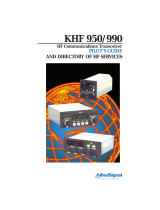Page is loading ...

HOW TO INTERPRET SATURO DATA
Review the SATURO data file and check that the water level is maintained (close
to 5 cm), the low and high pressure are sustained and close to the set value, and
the flux values for the last two pressure cycles are similar (comparing the same
pressure head flux values). It is also a good idea to look at the averaged flux values,
since the one-minute data are variable (which is why we provide the five-minute
moving average data). The SATURO only uses the last pressure cycle to calculate Kfs
and the standard error. The calculation also removes the first two minutes for each
pressure head, since during the first two minutes the instrument is coming to the
new pressure setting.
Refer to Figure 1 for an example of normal water level, pressure, and flux data.


Figure 1. Normal water level, pressure, and flux data
Even though it looked like the instrument had a difficult time coming to the high
pressure (Figure 1), this is not a problem and is actually a result of the algorithm for
maintaining the pressure heads. The clear differences in flux at the high and low
pressures are ideal; however, if the infiltration error is low, then it is acceptable if the
flux at the high and low pressure heads doesn’t have this obvious of a difference (see
Figure 2).


Figure 2. Example where increasing the high pressure head would be
recommended, but Kfs data are still good

Figure 3. Example of quasi steady state equilibrium being reached after three pressure cycles
If you find that data for the second cycle is better than the third cycle, then you can
manually calculate saturated hydraulic conductivity (Kfs). Contact METER support for
assistance.
To increase the flux for the high-pressure setting, increase the high-pressure
setting. In general for low-infiltration soils, a 10 cm difference between high and
low pressure head is needed. If the flux is too low or too high after the first cycle,
then stop the measurement and modify the settings. It is unnecessary to move the
infiltration ring unless the issue with the measurement is the location (too many
macropores or disturbed soil).
Consider modifying the settings to use a 20-25 minute hold time, and only run two
cycles. This may provide better flux data.
/



